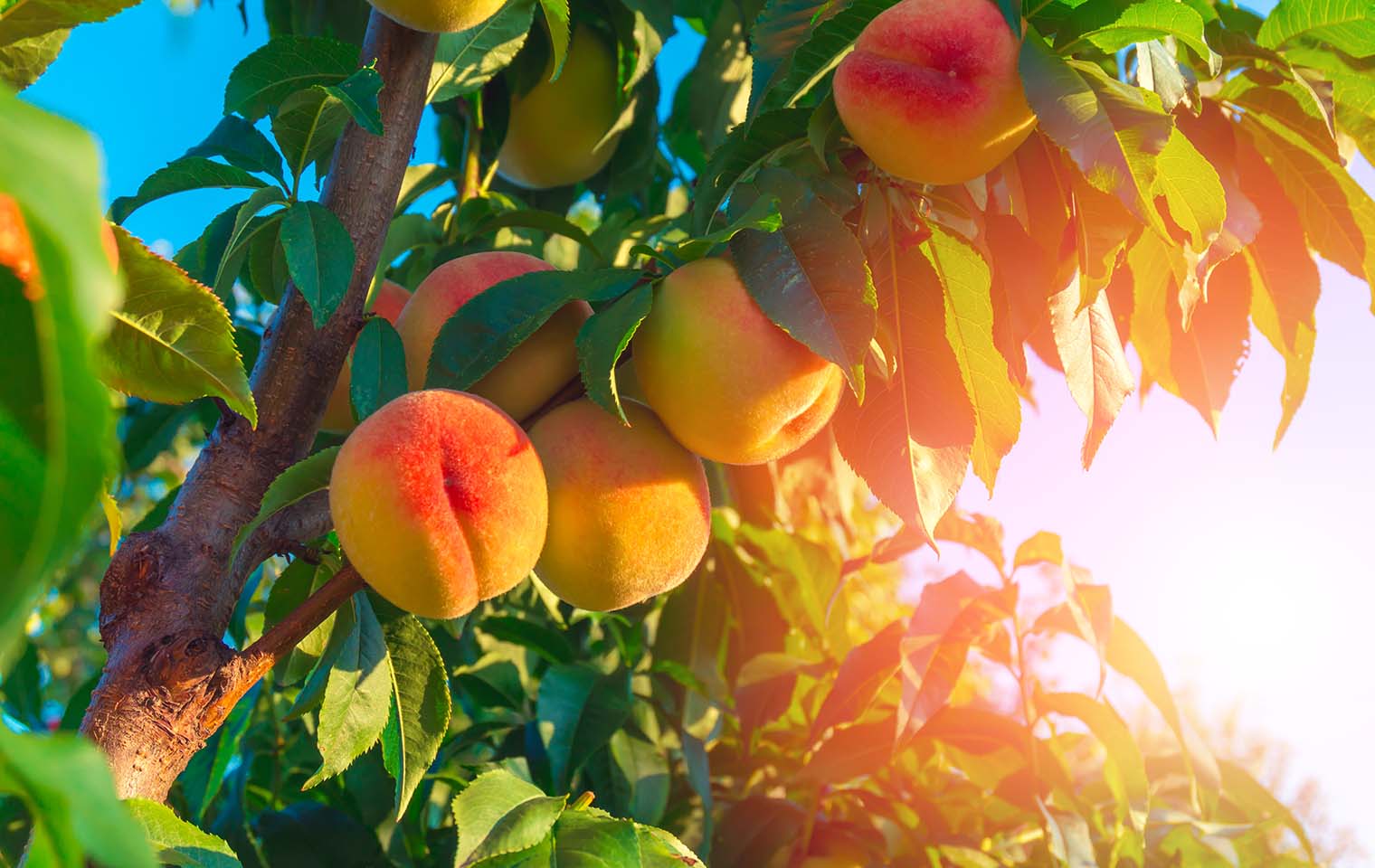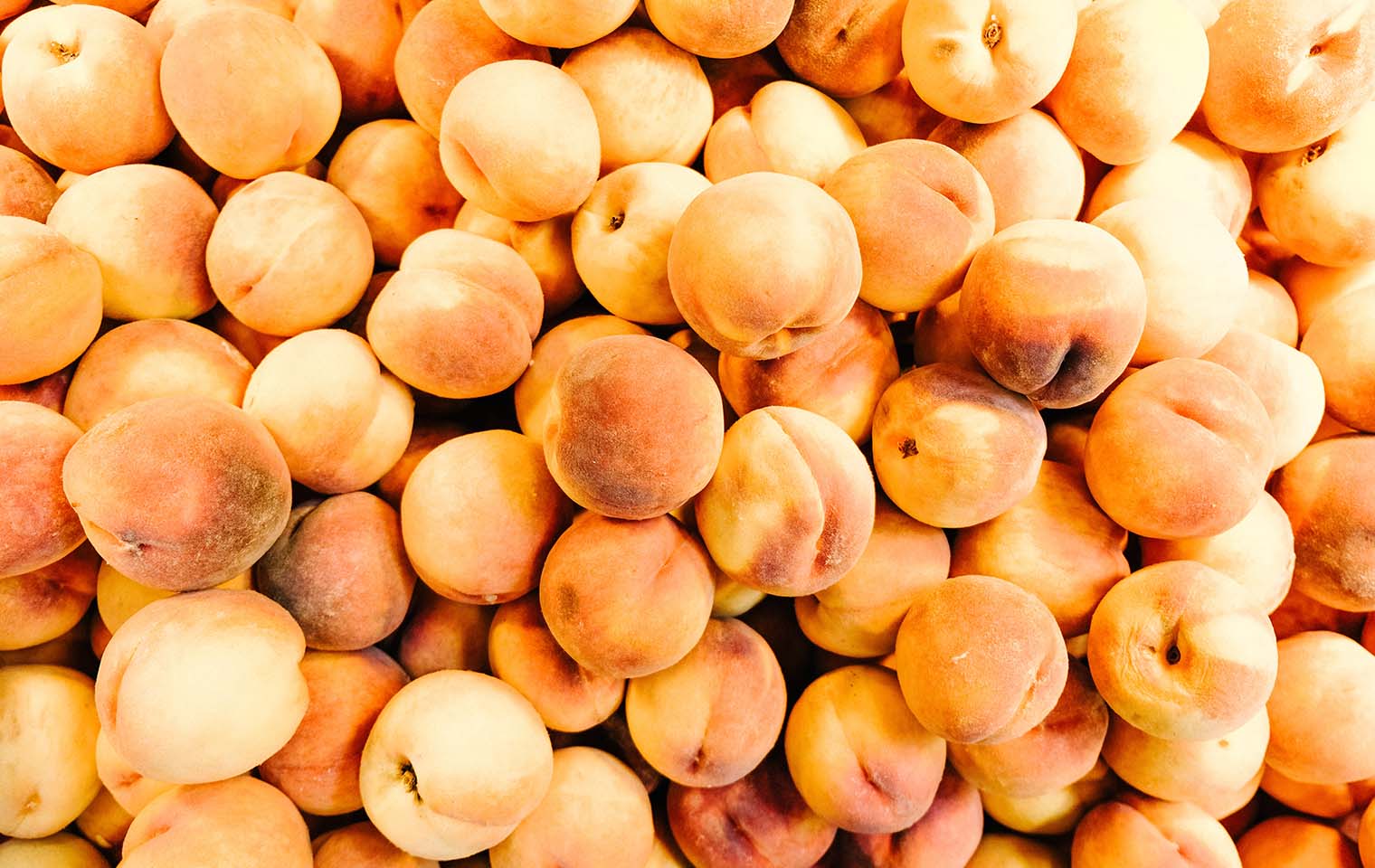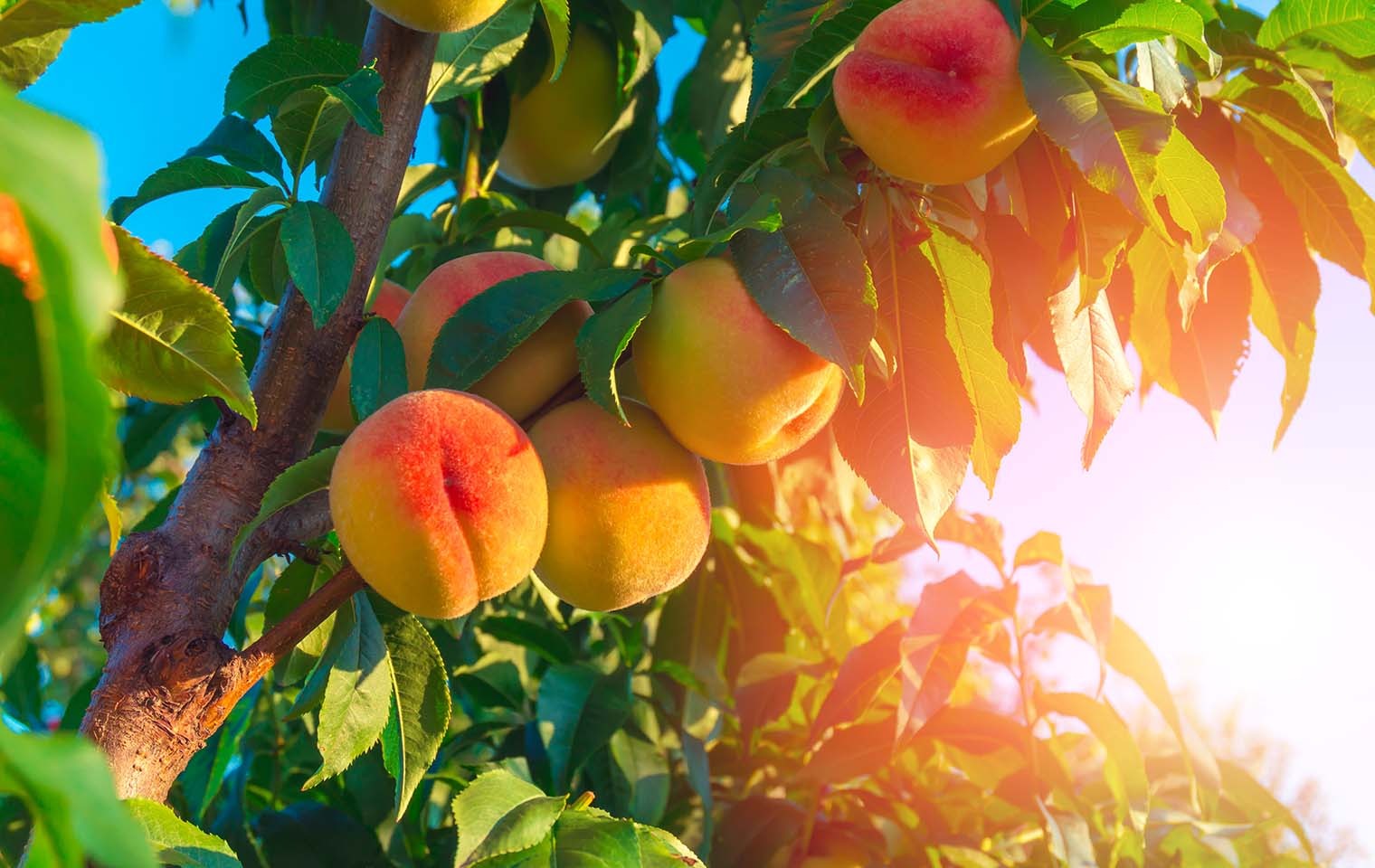Pretty as a peach
Nothing tastes better than a peach that’s been fully ripened by the sun, on the tree. If you live in the Western Cape, there’s no reason you can’t plant a peach tree in your garden and have your own supply of peaches that are sweet, juicy, full of flavour and straight from the tree, just as nature intended.
Along with plums and apricots, peaches and nectarines (Prunus persica) are members of the rose (Rosaceae) family. They grow throughout the most temperate regions of the Northern and Southern hemispheres and in South Africa, it’s the Western Cape, with its long hot summers and chilly winters that produces most of our peaches.
If you are lucky enough to live in the Klein Karoo, Cape Winelands or Witzenberg regions, you have the perfect environment for peach trees - whether just one, a few, or an entire orchard. Here’s our guide to getting your peach tree/s planted this winter.

CHOOSING YOUR TREE
Because peach trees are best suited to winter planting, you should be able to find them easily throughout winter. Choose one around a metre high, with a stem circumference of about a thumb. There may be a variety on offer, so be clear on what you like – peaches or nectarines, cling or dessert.
What’s the difference? Peaches and nectarines are essentially the same species, but peaches have a fuzzy skin, while nectarines are smooth. Both can be either “cling” or “dessert” types, and this is based on the stone or pip. Cling types have a pip that clings to the flesh, making it difficult to remove without causing damage to the flesh, while dessert peaches/nectarines have what is called a “freestone”, in other words a pip that is easy to remove. It stands to reason that cling peaches are often used for canning, jams, jellies and purees, while dessert peaches are ideal for fresh eating and desserts. The flesh can also vary – from soft and “melting” to fine or coarse. Decide what you want your peaches for and let that guide your choice.
One of the most popular clingstone varieties in South Africa is the Kakamas, also known as the Oom Sarel. It produces large round yellow cling peaches and the tree can grow up to 10m high. A popular freestone or dessert peach is the Snow White. It has a sweet pinkish-white flesh and can be eaten fresh or used in baking or for jam.
Other varieties to consider are Transvalia, with its red skin and fine-textured yellow to orange flesh, or the tasty Fairtime or Excellence varieties.

PLANTING YOUR PEACH TREE
First, choose the perfect location. You want to find the sunniest spot possible, as peach trees don’t do well in shade. Don’t plant in a dip or anywhere water might lie – a high, sunny, wind-protected spot would be best, ideally with fertile, light and well-drained soil, with a pH of 6.5.
It’s important that you prepare the planting holes well. Dig them fairly deep and very wide, breaking down the soil completely, removing stones, and adding generous amounts of compost. Don’t add fertilisers or chemicals at this stage as they can kill tender young trees. Let your newly-enriched soil settle for a few days before you plant your tree/s.
Stake your tree to keep it secure and wrap a plastic placemat, plastic piping with a slit cut into it, or similar, around the stem to protect it from annoying peach borer insects. This should be removed if it starts to inhibit growth, or once the stem is thicker and stronger. Mulch generously around your tree, but steer well clear of the stem, and then water your tree thoroughly. Depending on the rainfall you have in winter, you might need to water every week or two, increasing this a bit in spring and summer. You don’t want your roots to dry out completely, but the golden rule is to avoid your tree ever standing in water and the roots becoming water-logged.
Towards the end of winter, and at least 5 weeks after planting, you can fertilise your young tree/s with a balanced fertiliser for fruit (i.e. one that has all three major nutrients - nitrogen, phosphorus and potassium), and again around 6 weeks later. A high nitrogen feed once or twice a year will also help ensure healthy growth.
Give some thought to what you might plant around your peach tree/s, as this can help you to repel pests and attract pollinators. Strawberries are perfect to plant around a peach tree as ‘bait’ for moths so that they don’t lay their eggs in the fruit of your tree, and nasturtiums do the same for aphids. Basil is fantastic to plant near your tree as it is a natural repellent to pests, but its flowers will attract bees and other pollinators. To repel borers and help prevent leaf curl, you can plant garlic around the base of the tree, while planting chamomile and comfrey will add nutrients to the soil.
Finally, although peaches are self-fertile, the flowers need to be pollinated by insects, so you might want to consider planting more flowers to attract pollinators. If you love peaches and have the perfect sunny spot, it might be worth your while (not mention a fun and rewarding project) to create an entire world around a few of your favourite varieties of peach trees!

CHOOSING YOUR TREE
Because peach trees are best suited to winter planting, you should be able to find them easily throughout winter. Choose one around a metre high, with a stem circumference of about a thumb. There may be a variety on offer, so be clear on what you like – peaches or nectarines, cling or dessert.
What’s the difference? Peaches and nectarines are essentially the same species, but peaches have a fuzzy skin, while nectarines are smooth. Both can be either “cling” or “dessert” types, and this is based on the stone or pip. Cling types have a pip that clings to the flesh, making it difficult to remove without causing damage to the flesh, while dessert peaches/nectarines have what is called a “freestone”, in other words a pip that is easy to remove. It stands to reason that cling peaches are often used for canning, jams, jellies and purees, while dessert peaches are ideal for fresh eating and desserts. The flesh can also vary – from soft and “melting” to fine or coarse. Decide what you want your peaches for and let that guide your choice.
One of the most popular clingstone varieties in South Africa is the Kakamas, also known as the Oom Sarel. It produces large round yellow cling peaches and the tree can grow up to 10m high. A popular freestone or dessert peach is the Snow White. It has a sweet pinkish-white flesh and can be eaten fresh or used in baking or for jam.
Other varieties to consider are Transvalia, with its red skin and fine-textured yellow to orange flesh, or the tasty Fairtime or Excellence varieties.

PLANTING YOUR PEACH TREE
First, choose the perfect location. You want to find the sunniest spot possible, as peach trees don’t do well in shade. Don’t plant in a dip or anywhere water might lie – a high, sunny, wind-protected spot would be best, ideally with fertile, light and well-drained soil, with a pH of 6.5.
It’s important that you prepare the planting holes well. Dig them fairly deep and very wide, breaking down the soil completely, removing stones, and adding generous amounts of compost. Don’t add fertilisers or chemicals at this stage as they can kill tender young trees. Let your newly-enriched soil settle for a few days before you plant your tree/s.

Stake your tree to keep it secure and wrap a plastic placemat, plastic piping with a slit cut into it, or similar, around the stem to protect it from annoying peach borer insects. This should be removed if it starts to inhibit growth, or once the stem is thicker and stronger. Mulch generously around your tree, but steer well clear of the stem, and then water your tree thoroughly. Depending on the rainfall you have in winter, you might need to water every week or two, increasing this a bit in spring and summer. You don’t want your roots to dry out completely, but the golden rule is to avoid your tree ever standing in water and the roots becoming water-logged.

Towards the end of winter, and at least 5 weeks after planting, you can fertilise your young tree/s with a balanced fertiliser for fruit (i.e. one that has all three major nutrients - nitrogen, phosphorus and potassium), and again around 6 weeks later. A high nitrogen feed once or twice a year will also help ensure healthy growth.
Give some thought to what you might plant around your peach tree/s, as this can help you to repel pests and attract pollinators. Strawberries are perfect to plant around a peach tree as ‘bait’ for moths so that they don’t lay their eggs in the fruit of your tree, and nasturtiums do the same for aphids. Basil is fantastic to plant near your tree as it is a natural repellent to pests, but its flowers will attract bees and other pollinators. To repel borers and help prevent leaf curl, you can plant garlic around the base of the tree, while planting chamomile and comfrey will add nutrients to the soil.
Finally, although peaches are self-fertile, the flowers need to be pollinated by insects, so you might want to consider planting more flowers to attract pollinators. If you love peaches and have the perfect sunny spot, it might be worth your while (not mention a fun and rewarding project) to create an entire world around a few of your favourite varieties of peach trees!

PROBLEMS, PESTS AND DISEASES
Peaches and nectarines have the potential to be plagued by many ailments, but can just as easily have no problems at all. Do research and speak to your local nursery about how to avoid the most common problems, and deal with any issues straight away. The best thing you can do is keep your tree healthy. Remove any dead wood and – as mentioned before - never let your peach tree’s roots become water-logged as this is what brings problems. If you are serious about a beautiful and bountiful peach tree (or more), do what you can to create a healthy surrounding ecosystem.

HARVESTING
The size and number of your peaches will depend on many factors and could vary greatly from year to year. Generally, the more peaches on a tree, the smaller the fruit will be. After a few years of growth, you can influence this by removing some of the baby peaches very early in the fruiting season. It is also really important to always remove damaged or decaying peaches, so that only the good, healthy peaches are using energy from the tree.
Most varieties should be picked when they are just ripe – this means when their colour is fully developed, the flesh gives just slightly when pressed, and the fruit pulls easily away from the branch.

PRUNING
Pruning is a vital part of your peach tree maintenance. Not only does it encourage more fruiting, it also keeps the tree healthy, and allows you to control the shape and size, so that harvesting is easier.
Pruning is done to keep the centre open with the main branches angling upward at 45-degree angles, which is ideal for strong, fruit bearing branches. This open centre pruning method allows sunlight to penetrate throughout the branches. Each one of these main branches will produce more branches which also need to be spaced out. There are many guides and videos about perfect peach tree pruning, but as a basic guide, you will be removing all weak or diseases branches, any branches which grow, vertically, horizontally, or downward, and any which cross one another.
You will also be pruning to keep the tree low. By doing this, you’ll encourage the grow of side branches instead of tall branches, making your tree much easier to harvest, prune and care for.

IN THE KITCHEN
Peaches and nectarines are highly versatile. They are delicious eaten straight off the tree, and used to make jams, jellies, and chutneys, baked and fresh desserts. They can be dried, poached, braai’d or baked, and used in savoury dishes, such as salads and curries, and even in cooldrinks and cocktails.

The best way to ripen a peach is to leave it in the fruit bowl, but if you want to speed up the process, place it in a pierced paper bag with an apple or a banana. If you want to slow down the ripening, put your peaches in the fridge.
With just a little planning, planting and TLC, you could soon be savouring the sensation of biting into the freshest, most delicious peaches imaginable.



